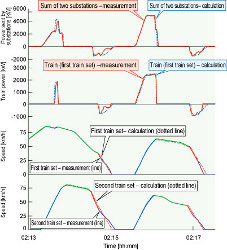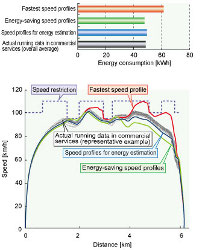15. Improved accuracy train energy consumption simulator
In order to reduce energy consumption in the railways, various kinds of both fixed installations and rolling stock side solutions are being investigated, and more accurate energy simulators are required to estimate the efficiency of each of these measures.
To this end, a traction power supply simulator was developed. Detailed calculations were made of the interaction between current and voltage between several trains and several traction substations, with precise speed profiles reflected by changes in acceleration due to voltage changes. In order to verify the fidelity of the simulator, comparisons were made between calculated and measured values obtained from tests using two trains running through a feeding section with two temporarily isolated substations. The results showed the correlation between the feeder current and the train speed was almost identical (Figure 1). It was confirmed that data about the trains’ energy consumption could be calculated to within 5%, and power for the substation to within 8%.
It is well known that energy consumption varies greatly in accordance with driving patterns, and therefore simulations need to be made by generating speed profiles which are as close as possible to reality. Two algorithms for generating speed profiles were developed: one for generating a speed profile for energy estimation, utilized to calculate average energy consumption of train operations, and one for generating an energy-saving speed profile which can be an example of train operations to reduce energy consumption. Verifications were made to ensure that the speed profile for energy estimation was indeed a realistic representation of actual driving, and its energy consumption was also close to the averages found in commercial train operations (Figure 2). Another result confirms that the low energy speed profile will enable energy-saving operations to be made.


